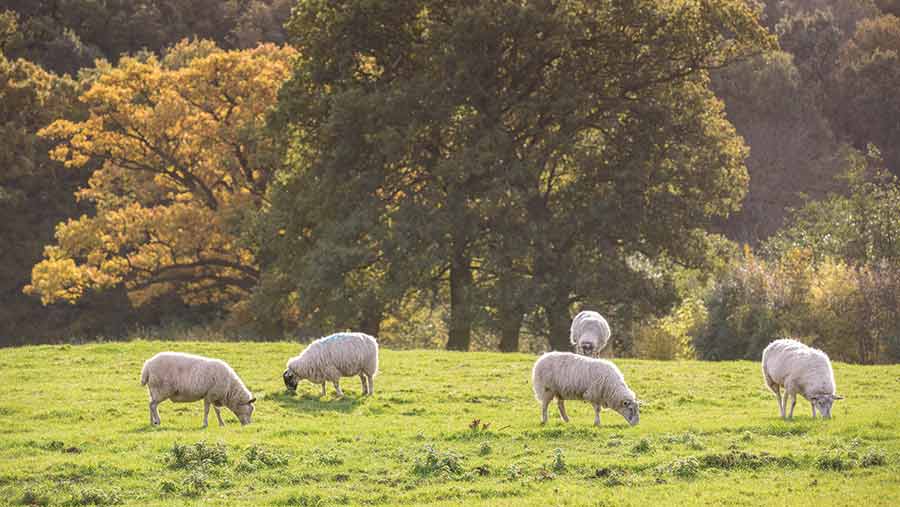Focus on sward heights in autumn to improve grass quality
 ©Tim Scrivener
©Tim Scrivener Sheep farmers need to avoid putting too much emphasis on building covers to fatten lambs and flush ewes in the autumn, and instead focus on sward heights, according to a grazing expert.
See also: Grassland management revival increases sheep output
Grassland specialist Chris Duller says building covers will only lead to wasted grass and poor sward quality and condition. Instead, he says attention should be placed on sward heights to improve both animal performance and sward quality.
Once a sward gets above 12cm, particularly in a mixed sward with weed grasses as well as ryegrass, quality can be lost as well as sward density.
Resting fields
Mr Duller advises farmers to flush ewes on the fields that need attention, giving poorer fields a break at some point over the winter.
“Ryegrass and clover need a chance to root and to grow so farmers need to make sure those fields that are a bit low in ryegrass and clover don’t get absolutely hammered all winter.”
Mr Duller who has been advising Welsh farmers at a series of Farming Connect grassland and soil clinics, suggests resting a couple of fields, even if it puts more stocking pressure elsewhere and more has to be fed.
“The net result will be longer lasting leys, less reseeding costs and better-quality grass in the spring,” he says.
Rejuvenation
Management changes can allow leys with a ryegrass content of just 35% to rejuvenate. “With just a little bit of attention, not dramatic changes, ryegrass levels can build up to 60%.
“Ryegrass is more competitive and aggressive than weeds – give it the right conditions and it will regenerate, tiller and fill gaps.’’
Top tips for managing sheep grazing leys this autumn
- Identify poorer fields, those with a low ryegrass percentage – avoid putting low-condition ewes here.
- Don’t waste grass and quality by grazing long swards.
- Keep animals moving – give grass a chance to recover and build sugar reserves.
- Don’t put stress on struggling fields in late autumn – give ryegrass and clover an opportunity to build.
Mr Duller says if autumn sunshine can get to the base of the ryegrass plant, then it is more likely to tiller – so ideally nothing taller than 12cm, he adds.
“If you can maintain a good leaf area through autumn and early winter, the ryegrass will be able to build and store some sugars to take it through until spring, so preferably nothing below 4cm.
“I don’t expect every single field to be managed to ‘ideal’ sward heights, but if you just try and achieve these targets with a couple of fields that are maybe a bit open and short of ryegrass and clover it will pay dividends next year.’’
Field MoT
Mr Duller recommends every field should be given an annual MoT. He says farmers should assess fields by first digging a hole to look at soil structure and underlying issues such as compaction.
He says there are key signs farmers can look out for that will indicate when a field is starting to go backwards.
In poorer fields at this time of year farmers will start to see a lot of annual meadow grass and creeping bent being pulled out by the sheep, leaving open and patchy swards.
Where soil conditions aren’t right (nutrients or soil structure), then weeds like creeping buttercup, daisies and sheep sorrel are likely to be evident. Also farmers are likely to see a build-up of dead material and thatch in the sward base along with moss.
“As soils wet up and temperatures drop you’ll see signs of stress on ryegrass where soil conditions aren’t right – red tinge to the leaves and more disease levels, which is evident through yellow leaf tips and dead leaf,” says Mr Duller.
Soil test and check soil structure to find out why the ryegrass isn’t happy.
Case study: Tydu Farm, Nelson, Caerphilly
Correcting soil pH at the 60ha Tydu Farm, near Nelson, Caerphilly, is enabling father and son Lyn and Adam Bowen to increase their flock from 300 to 400 and expand production of haylage for selling.
Their farm was once overrun with weed grasses, including Yorkshire fog and creeping bent, because the farm had been under-grazed for three years. The pH levels were low in most fields.
Lyn says: “The fields looked like they were productive, but they had no grazing value. We were going into the autumn with a thick thatch on the ground layer, which had been created by under-grazing, so the sunlight wasn’t getting to the base of the plant.”
A grass spiker had been used on some of the fields, but there was an underlying problem – the ground was lacking lime and the leys were tired. Soil tests established that pH levels ranged from 5.2 to 5.7.
To correct this, the Bowens have applied lime to 16ha over the past 12 months, at two tonnes/ acre – an investment of £2,000. They will spend a further £4,000 liming another 32ha over the next 12 months.

